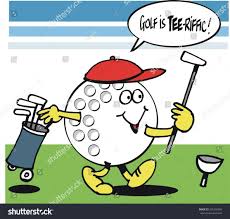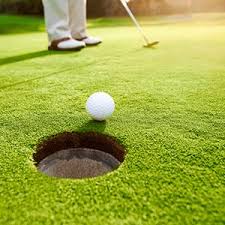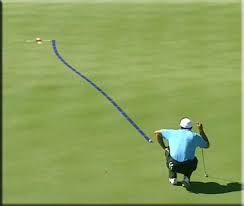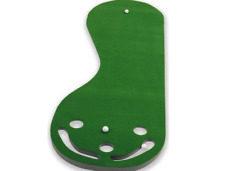Introduction
I’m sure you have probably been in the situation that I’m going to describe in a second, but first let me just refresh your memory about how you have gotten yourself in this position.
When you first started playing golf you probably spent most of your time working on your golf swing mechanics. Hitting your driver straight, hitting your irons the right distance and direction and finally working on your short game (chipping) in order to get your ball close to the hole.
 But chances are you have spent the least amount of your practice time on your putting. So back to the situation I mentioned earlier. There you are on the tee of say a par four and you hit your drive right down the middle, next you hit you second or what is called your approach shot on to the green, say twenty feet from the hole.
But chances are you have spent the least amount of your practice time on your putting. So back to the situation I mentioned earlier. There you are on the tee of say a par four and you hit your drive right down the middle, next you hit you second or what is called your approach shot on to the green, say twenty feet from the hole.
You walk up to the green and your thinking great I have a putt to make a birdie. You approach your ball and take your putting stance and you putt your ball.
All of a sudden much to your dismay your putt goes far right, away from the hole leaving you with a lengthy putt coming back, next thing you know you miss that one and you tap in for a five.
How demoralizing is that going to the next tee. What happened was you did not read the green properly. So here I’m going to teach you how to read greens like a pro.
Reading Greens
Reading greens is actually an art and the sooner you can master the art of reading greens the sooner you will make fewer putts in a round of golf and therefore lower your scores and your handicap. A lot of factors go in to learning how to read greens properly and some of these are:
- The type of grass you are putting on
- The direction of the grain of the grass
- Whether the grass is wet or not
Any or all of these conditions should be taken into consideration when determining where you will have to putt your ball in order to get your ball in or at least very close to the hole.
For instance if you are putting on a green that is damp or a little wet you may read your putt to break so much but the wetter grass will make your putt slower which in turn will make your putt break more than you thought, whereas a dry faster green will possibly not break as much and slide past the hole.
Develop a Green Reading Routine
Let me start with a major part of developing a proper green reading routine is to spend at least ten minutes on the practice green before you even get on the golf course.
Just about all golf course mimic their practice green to the exact cut and speed of the actual greens on the golf course. This will help dramatically when out on the golf course.
Once on the golf course and you get to the green your subconscious will take over and you will determine what speed you will have to hit the ball and what direction you will have to start the ball rolling.
Obviously if the ball goes in the hole you have read the speed and break properly. if,you missed the putt either left or right you have miss read the green. if, the ball did not reach the hole then you did not hit it hard enough.
This is one of the biggest putting mistakes because if the ball does not reach the hole it will never go in the hole. A good tip here is to always try to hit your putt a foot farther than the hole.
Another great tip for your green reading routine is this:
When you do hit your approach shot on the green, as you drive your cart or if you are walking pay close attention to the slope of the fairway in correlation with the slope of the green. This will give you an initial pre reading of the green.
If I’m driving in a golf cart I will drive up to the green and take my putter out and walk back ten or twenty yards back down the fairway and have another look.
Then walk up to the green and look at your putt from all sides. This should tell you if the putt is a downhill or an uphill putt and possibly which way it will break. The best way to read the break of the putt is ultimately behind your ball.
Your Final Decision
Once you have gone through your green reading routine and have come up with the direction and speed of your putt, do not change your mind.
When,you approach your putt and are ready to take your putt you will most likely start second guessing yourself about your decision, please try to resist this temptation at all costs. Always go with your first instinct, most of the time it will be right.
Do Not Get Angry
Remember one thing, you are not going to make every putt, even some of the most perfectly struck putt does not always go in. Many things can prevent a great putt from going in.
For instance a gust of wind could affect your putt, an improperly repaired ball mark could knock it off-line a little, even a small unseen pebble could affect it.
You’ve probably seen a putt that goes all the way around the hole and not go in. These are just part of this wonderful game of golf. Do not get angry, all this will do is carry over to the next hole which could be disastrous. Nothing good can come out of getting mad. It’s only a game.
In Leaving
Remember your focus should always avoid the dreaded three putts. if,you can avoid three putts you will knock a lot of strokes off your final score. if,you can play an eighteen hole round of golf with thirty-six putts or fewer you should consider this a very successful round of golf.
I like to look at this game as what I call bogie golf. Most golf courses are a par seventy or seventy-two, so if you bogie every hole you’re shooting a ninety or better and with practice the pars and birdies will come, lowering your score even more.
I hope you have found this article to be informative and helpful, if so please feel free to leave a comment below, and as always if you have any questions please feel free to ask and I will get back to you as so as possible.
Good Golf To You
Robert







